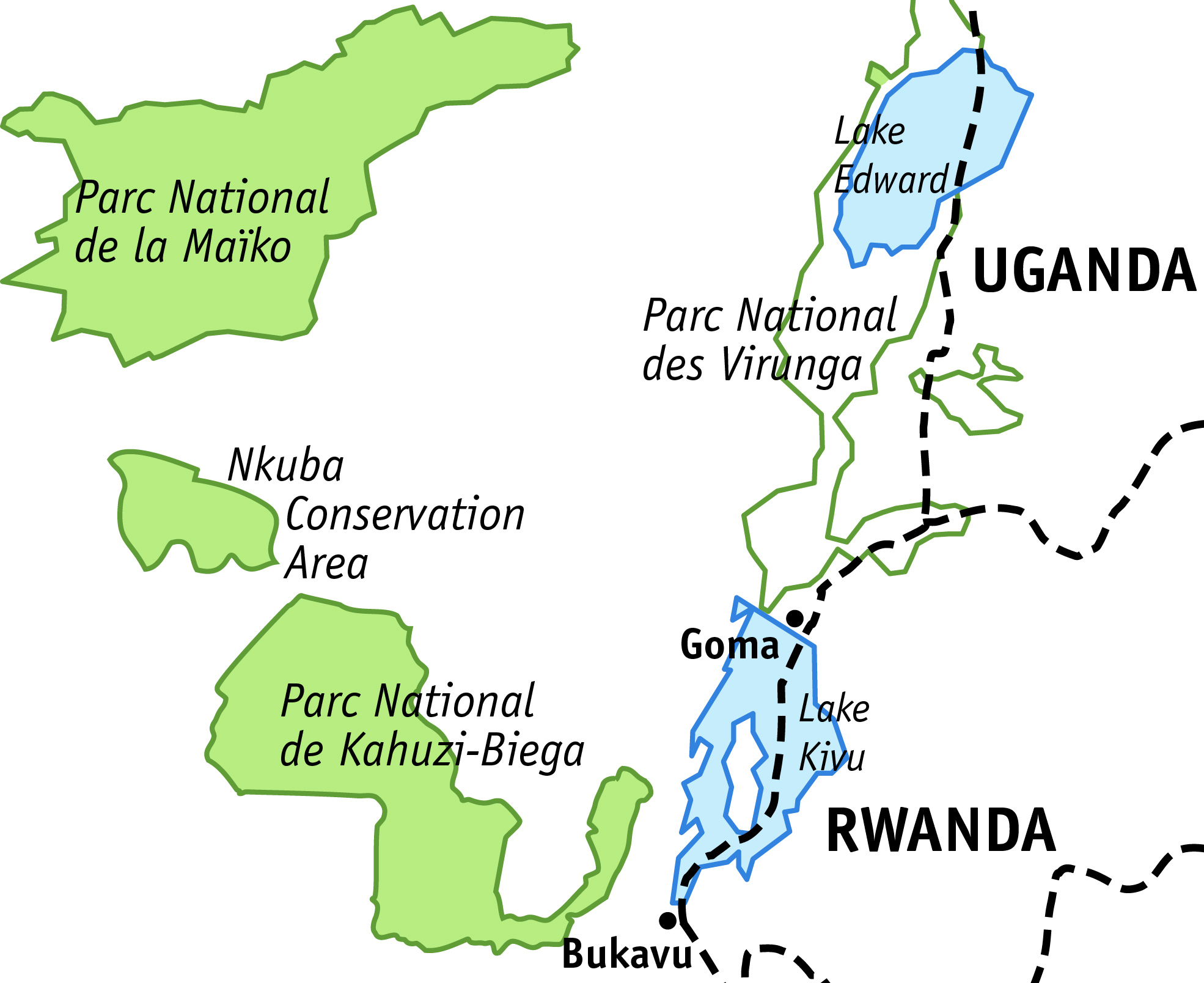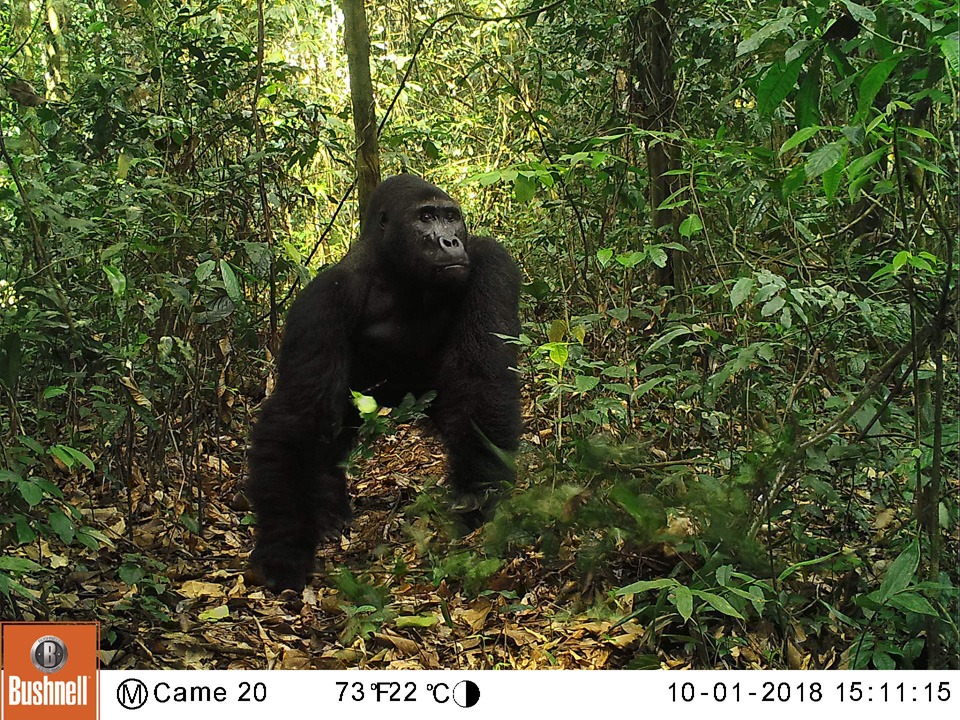Nkuba: a Community Reserve in Eastern D. R. Congo
Categories: Journal no. 64, Censuses, Protective Measures, Democratic Republic of the Congo, Other protected areas, Grauer's Gorilla
In 2012, the Dian Fossey Gorilla Fund International started a unique collaboration with local communities in eastern Democratic Republic of the Congo (DRC): to jointly protect over 2,600 km² of low-to-mid elevation (600 to 1000 m) primary rainforest for gorilla conservation while retaining community access and [sustainable] resource use. These efforts paid off last year (2021) when these forests, designated as the Nkuba Conservation Area (NCA), were officially recognised as a 'CFCL', a community forest conservation concession, by Congolese authorities. Furthermore, the first research findings to come out of the NCA highlight the value of these efforts and provide the incentive for enhanced commitment and institutional involvement in the area.
The foundational idea behind the establishment of the NCA was to protect the critically endangered Grauer's gorillas (Gorilla beringei graueri) and endangered eastern chimpanzees (Pan troglodytes schweinfurthii) that inhabit these forests. Large portions of the global populations of both of these threatened great apes are found outside the current network of government protected areas in the DRC, and the forests of the NCA harbour hundreds of these apes. As the first talks with local community members sparked activities related to conservation of the area and its biodiversity, the Dian Fossey Gorilla Fund also started research on this unique and rather undisturbed rainforest. For Grauer's gorillas, this research represented some of the first studies on this subspecies in lowland forests after early studies by Yamagiwa and Schaller, as the majority of past studies have been centred on a few populations in highland habitats (e.g., Kahuzi-Biega National Park).
The first insights gleaned from these studies were basic but elementary baselines for future studies, which provided knowledge on the food and space requirements of Grauer's gorillas. While fellow Grauer's gorillas (as well as mountain gorillas) in highland habitats may consume mainly vegetative plant parts, found in their immediate surroundings, the gorillas in the NCA travel further to eat a larger variety of food items such as stems, leaves, pith, bark, roots, and a decent amount of fruit, belonging to well over a hundred different plant species. Indeed, gorillas in the NCA travel far greater daily distances than their highland counterparts, show a relatively large variation in their daily movements, and move particularly far in months when fruit consumption is high (the September-December rainy season).
These gorilla-focused studies provided valuable scientific and conservation-focused insights. But, truly effective conservation of the NCA and its biodiversity depends on a more comprehensive understanding of the broader ecosystem, the other species that inhabit these forests, their interactions, and their role in ecosystem processes and functioning (e.g., with regards to carbon storage). Thus, Dian Fossey Gorilla Fund's efforts quickly expanded to include efforts to verify the presence of other species. A first paper focused on the description of faunal communities, in particular those elusive forest-dwelling larger mammals that are often the first to be affected by hunting or human disturbances to habitat quality.
This endeavour, which encompassed collection and analysis of thousands of hours of camera trap footage, further emphasised the importance of this community forest for conservation. Beyond the great apes, at least five other globally threatened species find a home in these forests: giant and white-bellied pangolins, leopards, African golden cats, and owl-faced monkeys. In addition, recent community-based participatory mapping exercises suggest that some globally threatened species still go undocumented - at least 22 additional larger-sized mammals and a 'plethora' of other biota. Clearly, these community forests in eastern DRC hold tremendous potential in terms of biodiversity conservation. Future research topics are almost limitless, since even the most basic aspects of ecology and behaviour of these species are unknown. These forests are important for conservation of gorillas, the species with which they share their habitats, and the complex ecosystem interactions that are key to a sustainable future for the Congo basin rainforests.
Yntze van der Hoek
Summary of
van der Hoek, Y., Binyinyi, E., Ngobobo, U., Stoinski, T. S. & Caillaud, D. (2022): Diversity and diel activity patterns of terrestrial mammals in the Nkuba Conservation Area, Democratic Republic of the Congo. Oryx, 1-11
References
van der Hoek, Y. et al. (2021): Diet of Grauer's Gorillas (Gorilla beringei graueri) in a Low-Elevation Forest. Folia Primatologica 92 (2), 126-138
van der Hoek, Y. et al. (2021): Daily Travel Distances of Unhabituated Grauer's Gorillas (Gorilla beringei graueri) in a Low Elevation Forest. Folia Primatologica 92 (2), 112-125


